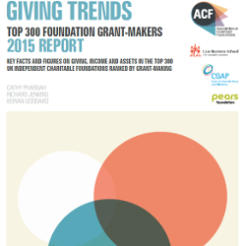Grantmaking by the UK’s top 300 charitable foundations has increased to £2.5bn in the year to March 2014, but is still 14 per cent lower than pre-recession levels, new research shows.
The report, Foundation Giving Trends 2015, published today by the Association of Charitable Foundations (ACF), shows that while total foundation grantmaking has risen, it is still some £400m short of where it was in 2008.
These findings are based on the annual reports and accounts of the UK’s top 300 foundations, which make up 90 per cent of all foundation giving in the UK, as well a survey of more than 300 ACF members, and other sources including tax statistics.
The report suggests that the biggest driving factor behind the increase in grantmaking in 2013/14 was the 3.6 per cent increase in foundation income. In all, 65 per cent of the top 300 UK foundations saw a real increase in grantmaking.
The total net asset worth of the top 300 also grew, with the total of £52bn representing real-term growth of almost 13 per cent since the last report. This was predominantly due to an £1.7bn increase in the funds of the UK’s biggest foundation, the Wellcome Trust.
The report also lists the top 300 foundations by their grantmaking. It is topped by the Wellcome Trust, which spent £487.7m in the year to September 2014, followed by Comic Relief, which spent £103m in the year to July 2013, and the Children's Investment Fund Foundation, which gave £68.6m in the year to August 2013.
For the first time, the report also explicitly measured the income and grantmaking activities of the top 45 UK corporate foundations. The £217m worth of grants made by corporate foundations accounted for around 9 per cent of the total top 300 giving.
Despite the positive growth, the report warns that this is “unlikely to ease the pressure faced by funds as government spending reductions bite ever deeper” in the coming years.
Of the research, co-author Cathy Pharoah said: “Better data on philanthropy is increasingly vital. It helps provide a realistic context for assessing the feasibility of political aspirations for the role of private philanthropy in public welfare provision. We also very much want to know whether philanthropy is growing at a time of increasing private wealth, but continuing social inequality.”









